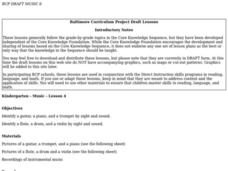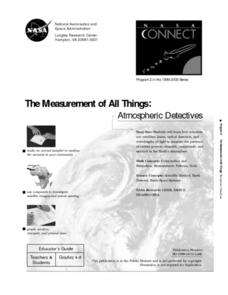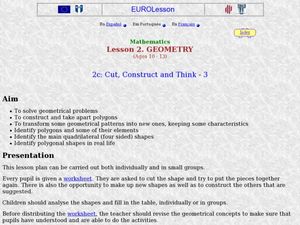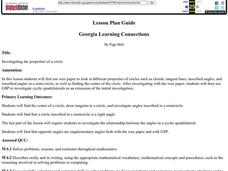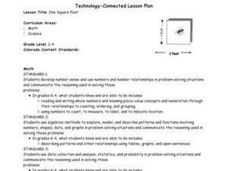Curated OER
Using Tens Frames for One to One Counting
Students complete a variety of exploratory exercises regarding counting through 10. They recognize the numbers 0-10 as represented using the quinary pattern on the tens frames. They are able to visualize the patterns for future...
Curated OER
Can Stack
Students are able to find the rule for summing consecutive numbers;
identify the pattern of triangular numbers. They then solve the given problem using logic and mathematical reasoning.
Curated OER
For Creative Minds: Even Numbers
Students practice identifying even numbers. In this even numbers lesson, students identify the pictures of even numbers, complete multiplication equations, and answer even and odd number riddles.
Curated OER
Marbles
Students act out the start of the given problem. They then brainstorm for ways to solve the problem and share solutions to the problem by identifying and continuing a repeating number pattern.
Curated OER
Tony Bennett: With Special Guests The Backstreet Boys - Lesson 2
Students clap four-beat rhythm patterns containing whole, half, dotted half, quarter, and eighth notes and rests in a given tempo. They clap the tempo as their teacher holds up flash cards.
Curated OER
Gee's Bend Quilts One
Third graders identify analogous and contemporary colors on the color wheel and identify the five facts about the quilts, women, and community of Gees Bend. Finally, 3rd graders pinned their fabric pieces to the copy paper in the exact...
Curated OER
Bubblegum balls
Students look for patterns to solve problems involving statistics using different colored gumballs. They should be able to look for and find out all the possible outcomes based upon inference and trials.
Curated OER
Speed + Graphing = Winners!
Fifth graders take addition timed tests every day for a two week period. Using the data from the timed tests, they create a bar graph using Microsoft Excel computer software, a personal bar graph using graph paper and colored pencils,...
Curated OER
Locating the Salt Front
Young scholars use Hudson River salinity data to create a line
graph that shows the location of the salt front, and use math
skills to explore how this location varies over time. They use the graph to estimate the location of the salt...
Curated OER
Are You Money Smart?
Learners figure out and discuss the irony of this coin-centric poem. They also practice persuasive letter writing, and identify and count coin/money values.
Curated OER
Musical Instruments
Students identify a guitar, piano, trumpet, flute, drum, and a violin by sight and sound. They view pictures of each instrument as they are played on a recording, discuss how each instrument makes their particular sound, and listen to...
Curated OER
Classifying Functions
Eleventh graders sort different types of functions including rational, periodic, exponential, polynomial, quadratic, logarithmic and linear using "function cards." The functions are displayed in multiple representations including...
Curated OER
Fractions of a Set
Third graders use fractions to describe part of a set. In this fractions instructional activity, 3rd graders are introduced to fractions through a book and use pattern blocks to describe a fraction as a part of a set. This instructional...
Curated OER
Graphs
Students identify the difference between two objects: a glove and a mitten. Those who like gloves raise their hands and receive a glove outline to color and cut out. Then those who prefer mittens will raise their hands and receive a...
Curated OER
The Great Button Sort
Students practice figuring out how items have been sorted. They also sort buttons in small cooperative groups. They color and sort their own paper buttons and then give their button sort to another student to see if he or she can figure...
Curated OER
Cut, Construct and Think - 6
Students identify polygons and calculate perimeter. In this geometric shapes lesson plan, students complete a worksheet identifying various polygons and calculating the perimeter of triangles and quadrilaterals.
Curated OER
Measurement
First graders participate in various activities dealing with measurement, length, volume, and temperature. They identify the need for standard units of measure, sort and classify objects, measure distances, and use a thermometer.
Curated OER
The Measurement of All Things: Atmospheric Detectives
Young scholars identify the characteristics of aerosols. Using remote sensing, they participate in an experiment in which they determine how the sun's radiation and elements in the atmosphere interact with one another. They also...
Curated OER
Cut, Construct and Think 3
Young scholars identify and create shapes. In this geometric shapes lesson, students identify various polygons and try to create new shapes using existing polygons.
Curated OER
Investigating the properties of a circle
Students use wax paper to look at different properties of circles such as chords, tangent lines, inscribed angles, and inscribed angles in a semi-circle, as well as finding the center of the circle, and use GSP to investigate cyclic...
Curated OER
Deer Tracks
Young scholars use satellite images to track to movement patterns of deer and examine deer behavior. They write stories about a day in the life of a field scientist.
Pennsylvania Department of Education
Creating Polygons
Students describe, make and compare polygons. In this creating polygons lesson, students identify properties of quadrilaterals and describe common features of two dimensional shapes.
Curated OER
One Square Foot
Learners identify, describe, count, tally, and graph life found in one square foot of land.
Curated OER
The Mandelbrot Set
Students explore the Mandelbrot Set. They are introduced to the concept of a complex number and function in order to motivate the discussion of Julia and Mandelbrot sets. Students investigate fractals and how they are built.










